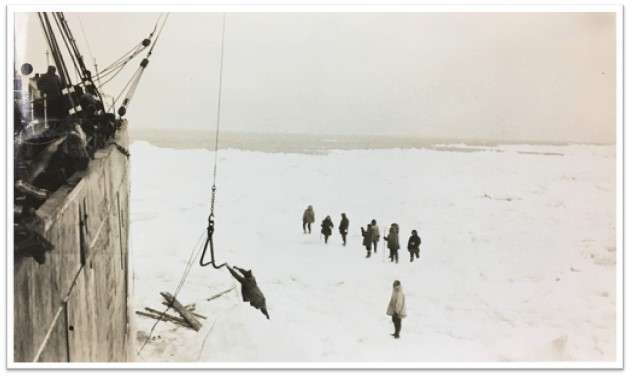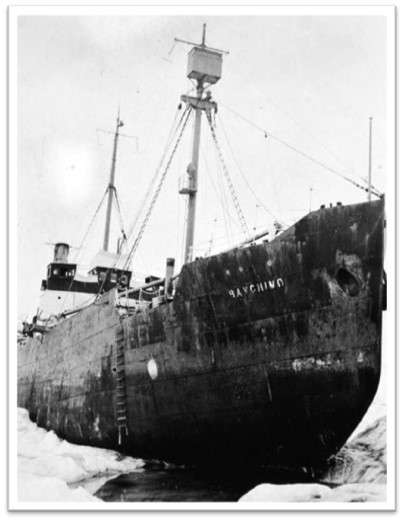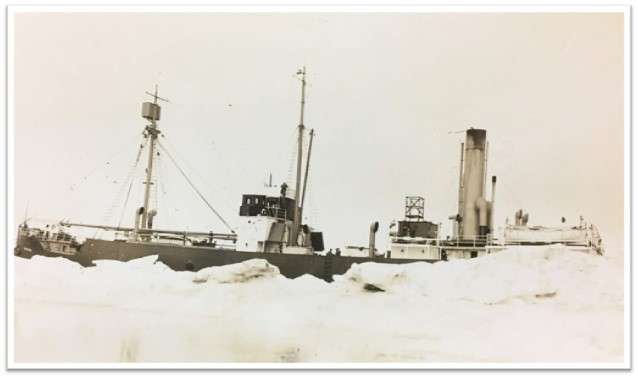At 1,322 tons, the SS Baychimo was an imposing cargo steamer launched by the Swedish merchant navy in 1914.

Little did anyone know that this nondescript steamer would become one of the most famous phantom ships of the 20th century, emblematic of the harsh and unpredictable nature of the Arctic seas.
Today we will delve into the life and mystery of the SS Baychimo, from its early voyages, its abandonment and subsequent ghostly appearances, to its present elusive status.
Early Years
Built during the first throes of the 20th century in 1914, the SS Baychimo was an impressive Swedish cargo steamer crafted by the renowned Lindholmens shipyard in Gothenburg.
The vessel was originally christened “Ångermanelfven,” reflecting its Swedish heritage. This formidable vessel embodied robust Nordic shipbuilding techniques, a design intended to tackle the harshest of maritime conditions.
In 1921, a pivotal moment in the ship’s history occurred when the Hudson’s Bay Company, a British trading company with a deep history rooted in North American exploration, acquired the ship.
 The bow of the SS Baychimo.
The bow of the SS Baychimo.
Recognizing the potential of the stout Swedish steamer, the company aptly renamed it Baychimo, readying it for a fresh chapter of service under a new banner.
The SS Baychimo was utilized primarily for trading expeditions across the frigid waters of the North American Arctic. Its core cargo typically comprised fur, a valuable commodity during those times, ore, and essential supplies like food, tools, and clothing.
These were meant for the numerous isolated settlements scattered throughout Canada’s vast northwestern territories, many of which were inaccessible by land routes.
The ship’s most vital mission was the ‘Arctic run,’ a yearly venture involving perilous maritime navigation through the ice-infested waters of Alaska and the Northwest Territories.
The Baychimo was specifically selected for these taxing journeys due to its robust construction and proven resilience. The ship made multiple successful runs.
Throughout its operational years, the Baychimo made these journeys, often under severe weather conditions.
Fateful Journey Of 1931
In 1931, a year that would prove to be a significant turning point in Baychimo’s history, the ship embarked on yet another of its routine Arctic runs.
This particular expedition would be anything but routine, forever immortalizing the SS Baychimo in maritime lore.
That year, the Arctic winter arrived unusually early and with an exceptional ferocity.
As the Baychimo navigated the icy waters near Barrow (now known as Utqiaġvik) in Northern Alaska, it found itself ensnared in the frozen grip of the rapidly forming sea ice.
Unable to break free from the icy clutch, the ship was effectively immobilized, and its crew was left with no choice but to abandon the ship temporarily.
 The SS Baychimo trapped in the icy waters.
The SS Baychimo trapped in the icy waters.
The crew, anticipating that the ice would soon thaw, enabling them to reclaim their ship, set up a makeshift camp approximately half a mile away.
However, their hopeful expectations were dashed as the weather conditions worsened. The Arctic winter showed no mercy, with temperatures plunging further, transforming the surrounding sea into a solid ice field.
When the crew members returned to their abandoned ship after the harsh conditions subsided slightly, they were met with an unexpected sight.
The Baychimo, their steadfast vessel, was nowhere to be found.
Given the severe conditions and the ship’s immobilization, they reasonably assumed that the Baychimo had been claimed by the Arctic depths, succumbing to the weight of the ice and the relentless power of the freezing sea.
Unbeknownst to them, however, the Baychimo had managed to free itself from its icy imprisonment.
The ship had not sunk, but had been swept away by the powerful currents under the ice, starting a new, uncanny chapter in its life – one that would transform it from a mere cargo ship to a spectral legend of the Arctic.
The story of the SS Baychimo was far from over; it was only just beginning.
Why Was The Baychimo Abandoned?
The Baychimo was abandoned because it got trapped in sea ice in the Chukchi Sea, off the northern coast of Alaska, during an early winter.
The captain and crew had to desert the ship, leaving behind its cargo. The trapping of the ship by sea ice and the challenging conditions led to the decision to abandon it.
Baychimo The Ghost Ship
As the Baychimo was swept away from its original location near Utqiaġvik, its crew members were entirely unaware of its new course.
Yet the ship was not destined to disappear into the icy Arctic obscurity. Instead, its unpredictable drift marked the commencement of its spectral existence, earning it a legendary status as an ‘Arctic Ghost Ship.’
The initial hint of Baychimo’s new identity was given by an Inuit seal hunter who happened upon the ship, stranded approximately 45 miles away from the crew’s camp, several days after its assumed sinking.
This surprising discovery prompted the original crew members to return to their seemingly unsinkable ship, hoping to resume their expedition. However, they were once again thwarted by the unforgiving Arctic weather.
Deciding to heed the warnings of the Arctic, the crew made a conscious decision to evacuate the Baychimo permanently, yet they were not ready to forfeit their valuable cargo. So, they returned to the ship, emptied it of its cargo, and left the vessel to the mercy of the Arctic elements.
 The crew removing the ships supplies and cargo.
The crew removing the ships supplies and cargo.
Unmanned and untouched, the Baychimo began an eerie, aimless voyage across the Arctic seas. Over the next several decades, the Baychimo was sporadically sighted, drifting aimlessly through open water or imprisoned within pack ice.
Its ghostly silhouette became a familiar apparition amidst the vast expanse of the icy Arctic.
The ship’s ethereal appearances were accompanied by a myriad of unsuccessful salvage attempts, as the weather conditions remained relentless, and the ship’s sudden disappearances kept it out of human hands.
One particularly eerie encounter occurred in 1933.
A group of unsuspecting Inuit hunters managed to board the ship during one of its periods of entrapment in the pack ice. However, a sudden blizzard swept through, trapping the hunters onboard for a span of ten days.
When the storm finally abated, the hunters discovered that they had been unwillingly transported approximately 250 miles away from their original boarding location.
This hair-raising incident only served to amplify the spectral reputation of the Baychimo, as it continued its unfathomable journey across the Arctic seas.
Last Known Sightings And Theories
The tales of the SS Baychimo, the ghostly vessel that seemed to have a life of its own, continued to permeate maritime narratives throughout the 20th century.
The last confirmed sighting of the Baychimo was reported in 1969, an astounding 38 years after its initial abandonment.
The sighting was made by a group of Inuit, who reported seeing the phantom vessel on the Beaufort Sea, off the Alaskan coast.
Remarkably, even after decades of braving the harsh Arctic conditions, the ship appeared to be in sound condition, continuing its solitary journey.
Since this final encounter, despite numerous expeditions aimed at finding the elusive Baychimo, the ghost ship has successfully evaded human detection.
Its continued absence from the eyes of curious seekers has given rise to a number of theories surrounding its fate.
One of the more pragmatic theories suggests that the Baychimo, after years of battling the brutal Arctic climate, finally succumbed to the harsh realities of nature and sank to the seabed.
 The stern of the SS Baychimo.
The stern of the SS Baychimo.
Given the severe weather conditions, constant exposure to ice, and the absence of maintenance, many believe this to be the ship’s most likely fate.
Contrastingly, there are those who argue that the Baychimo remains adrift, hidden under the Arctic ice or stealthily navigating the open waters, shielded from human eyes by the vastness of the Arctic landscape.
This theory aligns more with the ship’s legendary reputation, presenting an image of an indestructible vessel endlessly sailing the icy seas.
The Baychimo’s enigmatic story was so captivating that it prompted the Alaskan government to organize an official expedition in 2006, solely dedicated to locating the ship.
However, despite an exhaustive search of the Alaskan coast and employing modern technologies, the expedition failed to uncover any trace of the Baychimo.
The ship’s elusive nature continues to fuel speculation and inspire imaginative theories regarding its current location and state.
As of now, both theories – the Baychimo resting at the bottom of the Arctic Ocean or continuing its spectral journey – hold equal weight, as no concrete evidence confirming either has been discovered.
This lack of closure further adds to the intrigue and mystery that perpetually surrounds the Arctic’s legendary ghost ship, the SS Baychimo.
The Legend of the Baychimo
The SS Baychimo, over nine decades after its initial abandonment, remains a symbol of the unforgiving and unpredictable Arctic wilderness.
Its story has fascinated historians, marine archaeologists, and adventure-seekers alike, keeping alive the romantic notion of ghost ships that roam the seas.
Although the Baychimo’s physical presence remains unconfirmed, its legend endures, a chilling tale from the annals of maritime history.
Whether it is resting at the bottom of the Arctic Ocean or continuing its spectral journey is a question that remains unanswered, adding to the intrigue and mystery surrounding this Arctic ghost ship.





